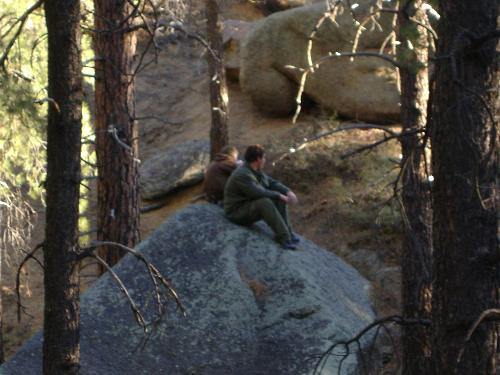I promised an account of how the course went for us and finally have time to put my thoughts into some sort of cogent writing.
The course as presented was less than expected. The instructor had planned (?) to do more hands on than what we were able to fit into the time frame. I believe that as this was his first time actually teaching this course that he might have been a bit overwhelmed by the amount of material to be covered and the time allowed. He relied heavily upon reading directly from the course material itself, though we did do several rotations using a backboard, cravats, dressings and other items. The plans to make use of moulage and to offer in sacrifice t-shirts and shorts to the trauma shears went to the way side.
The boys themselves got a bit of a shock when I demonstrated the effects of altitude - 7,200 feet at our event location - via the use of a pulse oximeter, which showed that even a healthy young boy of 14 who has never smoked a day in his life or is otherwise affected by asthma, etc, returns a value of only 94-95% oxygen saturation while sitting down vs. the 100% saturation that they would normally enjoy at lower altitudes. The adults present who were smokers could equal that value owing to their higher induced hemoglobin levels (more red blood cells to carry the oxygen). Prior to that little demonstration they didn't think they were affected by the altitude.

The picture was taken during our Spring Camporee, held on the same mountain but about 1,000' lower in elevation. Our course was held in the same terrain, using a hillside and a small open area as our classroom. Unfortunately, owing to time constraints, we weren't able to take advantage of a small cave to practice a rescue scenario as we had hoped to.
For kids this course was a big step above the regular FA merit badge. For the adults, two of whom were trained as Combat Lifesavers in the Army, it offered little new material but made for a welcome refresher.
Ideally any troop undertaking this course would follow it up with more hands-on practice. That is something we have tentatively planned for the future, when the younger Scouts can also partake in the fun. Our county has an active SAR team that is called out frequently to locate lost persons or to effect rescues over roadside cliffs or in the desert itself.
If we, as some here have mentioned they had to, were called to pay $100 or more for this course we would have approached it with far more hesitation. As it was the Troop covered the cost of food and transportation, and the participants themselves had to fork over $35 each for program materials (RC manual and training kit), RC certification cards and AHA CPR certification. For us, however, being able to meet the requirements for having appropriately trained members along for any future backcountry trips is worth the expense.
RR
Boys can save lives when Scouting first saves them.

